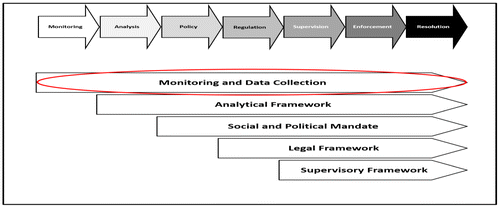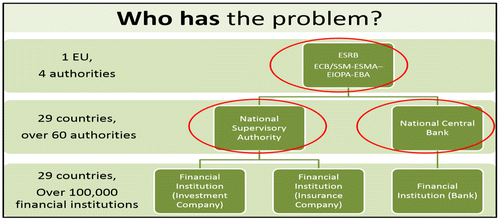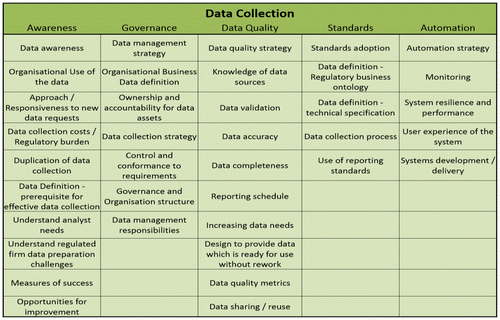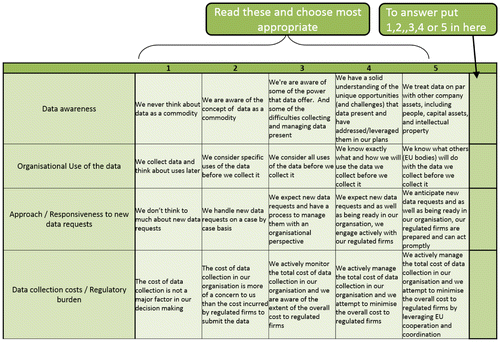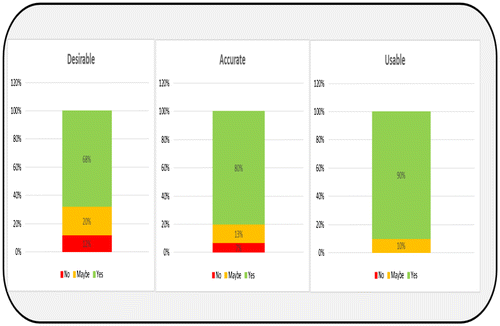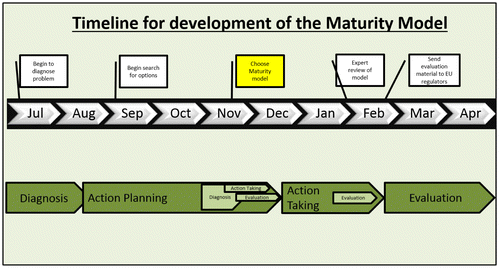Abstract
The financial crisis which began in 2008 has had catastrophic consequences for many people, communities, businesses and countries. Failures in financial regulation contributed significantly to the crisis. Regulatory convergence is seen as necessary to prevent a recurrence of the regulatory failures which contributed to the crisis. This paper offers a maturity model to assess the data collection capabilities of financial regulators, enable comparisons of these capabilities and thereby contribute to regulatory convergence. The model provides one small piece of the toolset needed to reduce the risk of future financial crises.
What is the data driven initiative being reported?
The provision of a framework by which financial regulators can assess the maturity of their data collection capability presented the opportunity for this data driven initiative. The framework provided is in the form of a maturity model. The maturity model aims to provide the means to:
| • | Assess the maturity level of data collection of EU financial regulators | ||||
| • | Compare data collection maturity levels of EU financial regulators | ||||
| • | Use the measures and comparisons to set common targets and drive convergence | ||||
| • | Create awareness of data collection concerns | ||||
The maturity model focuses on the monitoring and data collection pillar of the spectrum of regulatory engagement as per Moloney and Murphy (Citation2013) in Figure below and leaves it to others to assess and converge the other pillars.
The data collection pillar is presented as the most important of all the pillars. It spans all of the supervisory activities and all of the other pillars of the model. ‘One of the hard lessons which financial authorities learned from the financial crisis was that a lack of reliable data hindered critical policy formation and decisive crisis management’’ Moloney and Murphy (Citation2013).
Who benefits from the initiative?
Figure below explains who has the problem and therefore can benefit from the use of the maturity model. There are 29 countries and over 60 National Supervisory Authorities (NSAs) in the EU and regulation is done nationally. In Europe there are also four supra-national European Supervisory Authorities for financial regulation
| • | ECB/SSM – European Central Bank – regulates systemically important banks | ||||
| • | ESMA – European Securities Markets Authority -regulates securities markets | ||||
| • | EIOPA – European Insurance and Occupational Pensions Authority - regulates insurance companies and pension companies | ||||
| • | EBA – European Banking Authority – regulates the Banks the ECB/SSM doesn’t | ||||
The ESRB – European Systemic Risk Board at the ECB also monitors overall financial stability.
The NSAs and ESAs are currently implementing a raft of new legislation drawn up in response to the financial crisis. Consistency of approach and implementation is needed to ensure a level playing field for firms to operate in across national boundaries - financial regulation is ‘an industry without borders’ (Moloney and Murphy Citation2013).
One major regulatory change which occurred recently was the creation of the Single Supervisory Mechanism (SSM) at the ECB for the direct supervision of the EU’s most systemically important Banks. Data required by the SSM is collected and validated at a national level via NSAs and then forwarded to the SSM.
This highlights the need for convergence and shows how the ESAs NSAs and firms operating across national borders can benefit from the use of the maturity model.
Why is it an important initiative?
The financial crisis has had catastrophic consequences for many people, communities, businesses and countries since 2008. Failures in financial regulation have contributed significantly to the austerity measures seen in many European countries including Ireland, the collapse of Anglo Irish Bank and the Irish bailout.
Governments and regulators have responded to this financial regulation failure with a change in approach from principles based regulation to rules based and with legislative change to set out and enforce the rules. Moloney and Murphy (Citation2013) argue that convergence of approach between countries is also necessary ‘to prevent a reoccurrence of the events leading up to the crisis’ As the financial markets become more global and more complex, greater convergence of regulatory approach is being called for.’ In essence they argue that the same rules and the same implementation of the rules is necessary internationally to help prevent another financial crisis
As a result of the financial crisis a long list of new financial regulations are being implemented across Europe. Each of these regulations requires regulators to collect data from financial institutions to monitor that the rules are being complied with. Where non-compliance is detected regulatory action will be required.
Convergence in the regulatory approach will contribute to the elimination of regulatory arbitrage and the creation of a single regulatory approach across borders. Convergence in the regulatory approach can help prevent future regulatory failures and resultant financial crises.
The development of the maturity model to measure data collection maturity is one small step in the prevention of future financial crises.
How was the initiative implemented?
An Action Research (AR) approach was used to design and develop the maturity model and the rigour cycle of Design Science was used to evaluate it.
AR is a research method focussed on the dual goals of solving organisational problems and contributing to scientific knowledge. AR follows a five stage cycle – diagnose, plan, take action, evaluate the outcome, specify the research learnings and iterate again through the cycle.
The main steps in this project were:
| • | Ensure a new maturity model was needed | ||||
| • | Define the scope and structure of the maturity model | ||||
| • | Develop maturity model iteratively | ||||
| • | Evaluate the maturity model | ||||
Need for the model
Regulatory convergence is seen as necessary to prevent a recurrence of the regulatory failures which contributed to the crisis. The project sought a way to assess capability and enable convergence and concluded that a maturity model was the best way to address this need. A review of the literature and trade press showed that there were no models in existence for data collection so there was an opportunity to design and develop one.
Scope
The scope of the maturity model focused on the descriptive and comparative aspects of maturity models.
| • | Descriptive: Model applied for as-is assessments where the current capabilities of the organisation under investigation are assessed with respect to given criteria | ||||
| • | Comparative: Model allows for internal or external benchmarking | ||||
Domain experts and literature review were used to determine the dimensions for the maturity model – awareness, governance, quality, standards and automation.
The lists of elements for each dimension is shown in Figure below. In total there are thirty-seven elements, ten in awareness, seven in governance, ten in data quality and five in each of standards and automation.
Develop maturity model iteratively
An initial prototype was developed at the outset of the engagement with the domain expert group to help define the structure and dimensions for the model. Each dimension was then developed with a number of iterations and having iterated through the five dimensions a further iteration reviewed them for consistency and to remove duplication.
Once responses are entered into the maturity model the model calculates the overall maturity score and the maturity score per dimension.
With the content of the model completed the final stage in its development was to add the explanatory documentation. The documentation explains the concept of a maturity model, defines the scope and purpose of the model and provides instructions on how to use it.
Evaluation
The maturity model was evaluated as follows:
| • | Evaluation measures defined | ||||
| • | Relevant metrics for these measures researched | ||||
| • | Evaluation questionnaire developed based on the measures and metrics | ||||
| • | Evaluation questionnaire and maturity model reviewed with the domain expert group | ||||
| • | Evaluation questionnaire sent to regulators in 29 countries | ||||
| • | Responses received from less than ten countries | ||||
| • | Rubrics produced and responses analysed | ||||
| • | Conclusions drawn from the evaluation questionnaire | ||||
Overall the responses and comments received indicate a desire for the maturity model, that it is accurate in reflecting the real world of financial regulation and that it is easy to use.
This positive reflection on the maturity model, particularly the desirability of the maturity model, must be tempered by the response rate.
In order to be more confident in the desirability of the maturity model it would be necessary to follow up with more of the countries and see if the responses follow the same pattern.
Feedback from respondents, colleagues in EU Financial Regulators or Central Banks, shows that they see value in the use of the model.
‘This could be very valuable to the European Commission’
‘A very professional and thorough project! Very very impressive.’…
These comments show that the maturity model could be used in organisations across Europe and the respondents see a value in doing so.
Analysis of the evaluation responses at dimension level – awareness, governance, data quality, standards and automation revealed that awareness and governance scored lower than the other three dimensions.
When did this initiative take place?
As shown in Figure below the model was developed over the period from July 2014 to April 2015.
It is interesting looking back to note that it took a similar amount of time to diagnose the problem and decide on the maturity model as it did to build the model itself. There were certainly times when in order to make progress, pushing ahead with an earlier option and ‘making it fit’ felt appropriate. However continuing to investigate and diagnose paid off. Development of the maturity model did not require ‘making it fit’ and meant the development could move ahead smoothly and quickly.
It highlights the necessity to ensure the right problem is being solved and the solution is fit for the problem at hand.
Where is the business value being realised from this initiative?
This initiative has provided a maturity model which can advance the financial regulation convergence agenda as well as be used by individual organisations in their improvement work. The maturity model has been well received and some next steps can be taken to progress its development further.
ESAs and the NSAs can benefit directly by the use of the maturity model. In improving and harmonising their data collection processes they will reduce regulatory arbitrage and provide a similar regulatory reporting process across Europe. In doing so it is expected that they would also reduce their costs.
The financial institutions who report into the NSAs would also benefit from a consistent approach across each country and for larger institutions who operate in many countries their costs would also be reduced.
The debate on regulatory convergence is growing as evidenced by recent publications - Duff and Phelps Global Regulatory Outlook 2016 - and conference topics - 6th City Week 2016: The International Financial Services Forum. The maturity model itself and the approach taken to develop it can contribute to the debate and help provide approaches to regulatory convergence.
From a personal perspective I also benefit from the creation of the maturity model. I have left the Central Bank and have set up two companies since leaving. Through one of these I provide data consultancy to companies. I find that the model provides a foundation for asking many of the questions needed to understand the information supply chains of the companies I work with.
Disclosure statement
No potential conflict of interest was reported by the author.
Reference
- Moloney K., & Murphy G. (2013). The spectrum of regulatory engagement. Law and Financial Markets Review.

